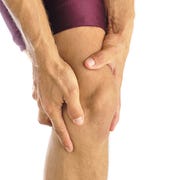Of more than 900 new runners, 27% got injured during their first year in the sport, and shin splints were the most common injury, according to new research published in PLoS One.
Danish researchers followed 933 new runners for a year to see how many got injured, what injuries they incurred, and how long it took the new runners to recover from their injuries. They considered someone a new runner if he or she hadn't run more than 10 kilometers in the preceding year. They defined a running injury as running-induced pain in the legs or lower back severe enough to curtail training (distance, duration, pace or frequency) for at least a week.
Of the 933 new runners, 254 met the definition of having a running injury during their first year. Of those injured runners, 15% had medial tibial stress syndrome (the preferred medical name for shin splints), 10% had patellofemoral pain (AKA runner's knee), 9% had a meniscus injury, 7% had Achilles tendinitis, and 5% had either plantar fasciitis or a soleus injury (along the back of the lower leg). Stress fractures were relatively uncommon, most likely because in their first year the new runners' mileage was low enough to not create significant risk for that injury. Three-quarters of the injuries occurred during a given runner's first 201 kilometers (125 miles) in the sport.
Healing time varied widely among the injured runners. Those with calf strains were back to normal running in an average of 30 to 40 days, while those with shin splints needed an average of 72 days to fully recover. Plantar fasciitis was the peskiest of the common injuries, requiring an average of 159 days to get over. In all, 220 of the 254 injured runners recovered by the end of the one-year study, while 34 were still injured.
The researchers say that their findings emphasize the importance of new runners being mindful of shin splints. In the video below, Jordan Metzl, M.D., describes how to prevent and treat that injury.

Scott is a veteran running, fitness, and health journalist who has held senior editorial positions at Runner’s World and Running Times. Much of his writing translates sport science research and elite best practices into practical guidance for everyday athletes. He is the author or coauthor of several running books, including Running Is My Therapy, Advanced Marathoning, and Meb for Mortals. Scott has also written about running for Slate, The Atlantic, the Washington Post, and other members of the sedentary media. His lifetime running odometer is past 110,000 miles, but he’s as much in love as ever.








